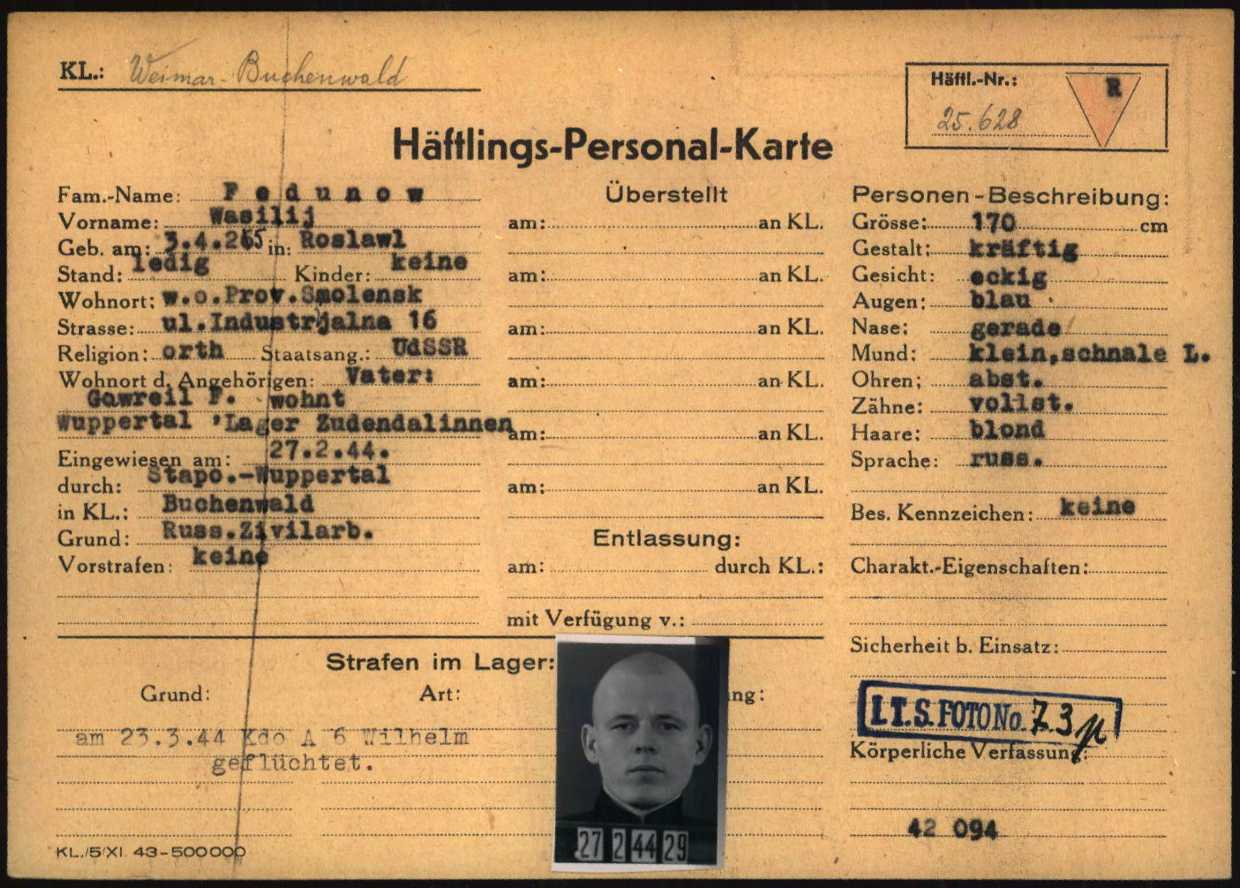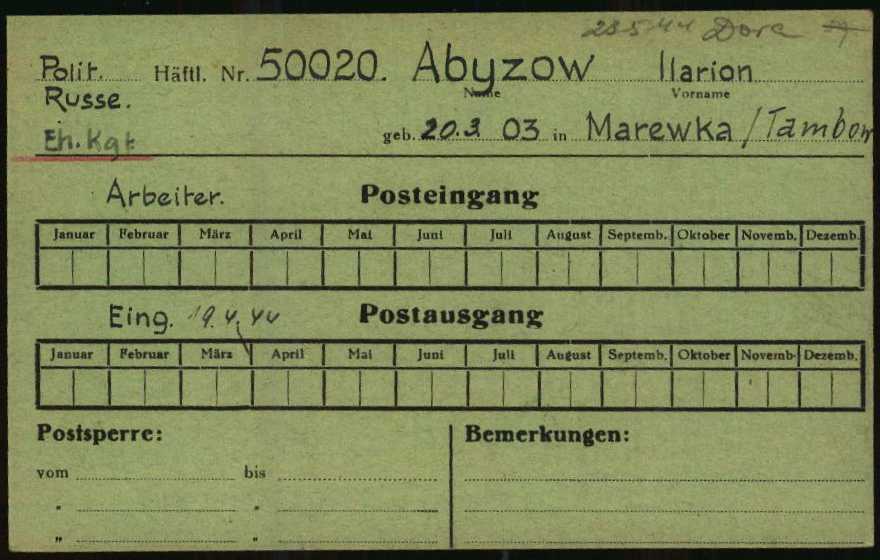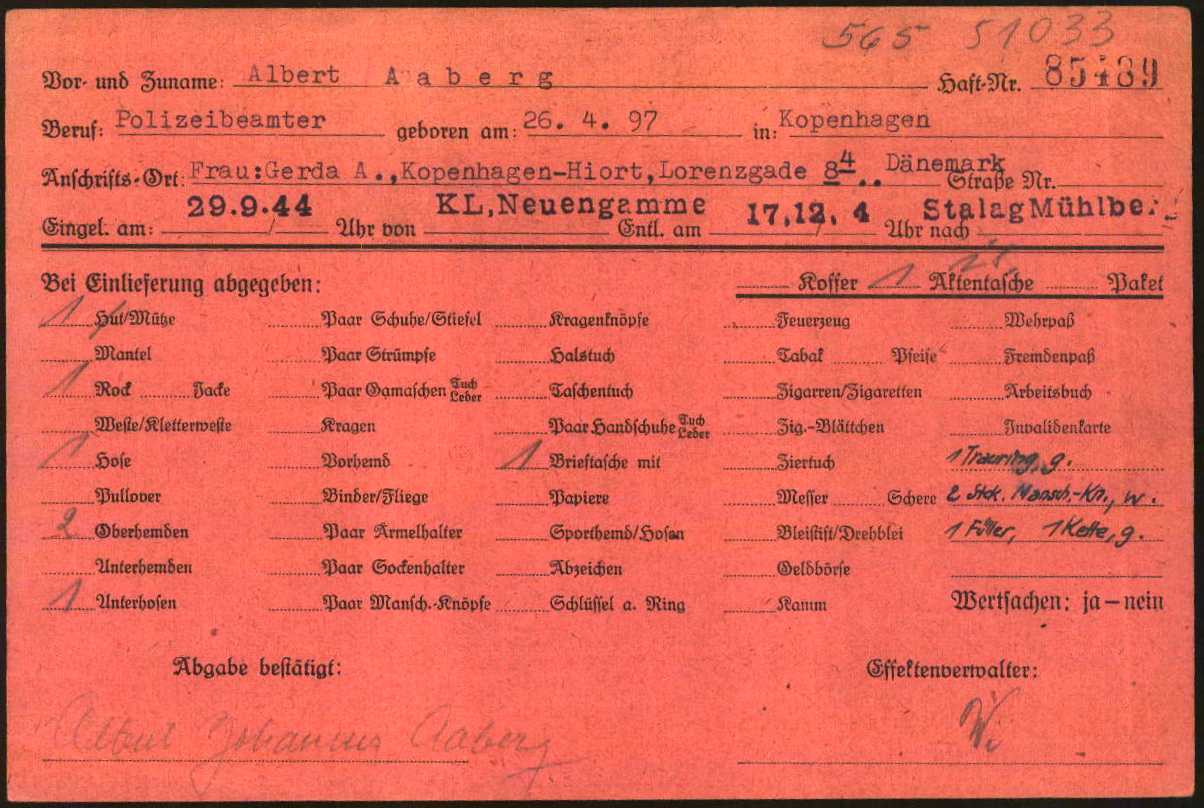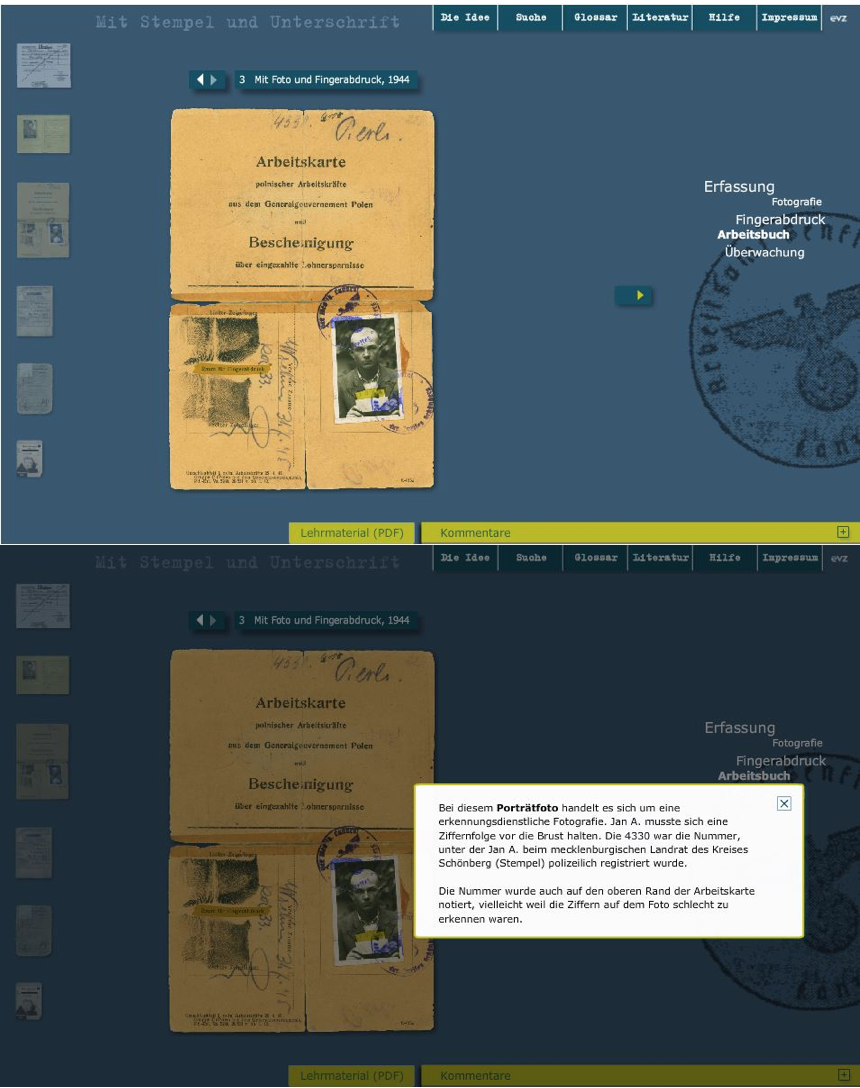Introduction
The e-Guide Concept
The “malaria card” as an Example of an e-Guide Description
Conclusion
Introduction
In 2018/2019 the International Tracing Service (ITS)1 extends the online accessibility of further parts of its 30 million documents on the fate of Holocaust victims, forced laborers and Displaced Persons. Following the online publication of documents on the Child Search Branch and the death marches, one of the next major digital collections of the ITS will focus on documents from concentration camp inmates. Thus, two questions arise: Will users – especially non-academic ones like family members of survivors or students working on the topics of Holocaust and forced labor – be able to “decode” the documents? Can the average user as well as the academic one answer questions like what exactly can be read on a personal effects cards (Effektenkarte) or what a registration office card (Schreibstubenkarte) was used for?
Therefore, the ITS decided to develop an online guide – the so-called e-Guide – to describe the most common document types, their origin, the obstacles a user may face working with them and the meaning of terms and variations. This digital interactive tool will support a broad user group’s understanding of the historical documents.
BACK
The e-Guide concept
General idea
The main idea behind the historical contextualization and explanation of documents in the e-Guide is to enhance the understanding of documents held in the ITS archive. In the first phase the e-Guide focuses on the approximately 30 most common document types of individual concentration camp inmates (see Fig. 1.1-1.3).2
In their daily work, ITS staff often experience that several groups can have difficulties in coping with these documents. The ITS Tracing Branch faces questions of relatives who received copies of documents on their parents, siblings or other family members. The Research and Education Branch uses documents like the prisoner registration card (Häftlings-Personal-Karte) in workshops with high school or university students. They experience that participants often tend to focus extensively on small details and thus prolong discussions aside from the historical documents. The positive side of this observation is that people are aware that even the smallest information can be important. Nevertheless, it shows as well that easily accessible information about the documents is required in order to fully understand them.
An example is the transport card from Amersfoort (see Fig. 2). Here the abbreviation “Z” is the only proof that a person was deported to Zwolle where the inmates had to work on the fortification on the IJssel river. Through the work on and with the cards it became more and more evident that every small stamp or scribble can be of great importance – and therefore should be explained.
Composition of the e-Guide
The e-Guide is designed in a way that it is appealing to several quite different groups working with ITS documents – from (mostly non-German speaking) relatives who receive copies of documents from the ITS to German high school and university students taking part in educational projects or research workshops. The e-Guide faces this challenge of different users with varying levels of knowledge by offering the explanations in a non-intricate language, as low-threshold access and in a bilingual version in English and German.
Regarding the presentation of information, it was most important – from the developers’ point of view – that a user should be able to choose what explanation he or she requires. Here the e-Guide follows features like in the representation of historical documents on the EHRI Document Blog3 or on the website www.mit-stempel-und-unterschrift.de (see Fig. 3)4.
At this point the advantages of a digital solution become evident: Access to the information through a digital guide differs fundamentally from the possibilities that a traditional publication as book or flyer could offer because the e-Guide basically adapts to the level of knowledge of each user by letting him or her decide which information is needed.
For each historical document type, the ITS e-Guide presents a main sample card and additional cards showing variations. On the main card – that allows to enlarge it and to zoom into the document – the parts to which additional explanations are available will be highlighted with overlays. Depending on his or her previous knowledge the user can choose what information is relevant for him or her and which is not. A high school student on the one hand might for example need the explanation of the triangle categories that were assigned to the camp inmates while an experienced academic user on the other hand might not activate the pop-up window connected to the overlay on the triangle symbol.
Next to the main card one will find variations of the card e.g. versions written by hand or with a typewriter, with further symbols, with or without pictures or in different colors. The personal registration card (Häftlings-Personal-Karte) for example is conveyed in the ITS archive in not less than four different colors including brown, yellow, blue and green cards (see Fig. 4). These variations are supposed to simplify the recognition process if a certain card is in fact this type of document even though it might look different in a few aspects.
In cooperation with several national and international archives, memorial institutions and individual experts it was possible to answer a fixed set of contextualizing questions for each document. The questions and their answers shed light on the historical situation in which the cards were created:
- Where was the document used and who issued it?
- When was the document used?
- What was the purpose of the document?
- How frequent is this document (in general and at the ITS)?
- What do you have to take into consideration while working with the document?
Links to additional features are included in the answers to those five questions that can be activated if the user wishes to do so. The links present further documents from the ITS archive (e.g. orders of documents addressed to the central printing shop in Auschwitz), quotations from reports by survivors on what the document meant to them during the war and lists of abbreviations or of labor detachments. The latter for example will help to decode the name of an Arbeitskommando behind the hand-written number on a registry office card. Two features complete the e-Guide: a general introduction to the ITS documents and a search function that leads the user to the document description even if he or she does not yet know which type of document might be in his or her hand.
Technical aspects of the e-Guide
The e-Guide is an online tool that offers a user-friendly front end. The guide itself is a TYPO 3 solution that is implemented as a subdomain into the ITS website. The design implementation works via HTML5/CSS3. As it is expected from current technology, the e-Guide is designed responsively and adapts to different formats as tablets, smartphones etc.
BACK
The “malaria card” as an Example of an e-Guide Description
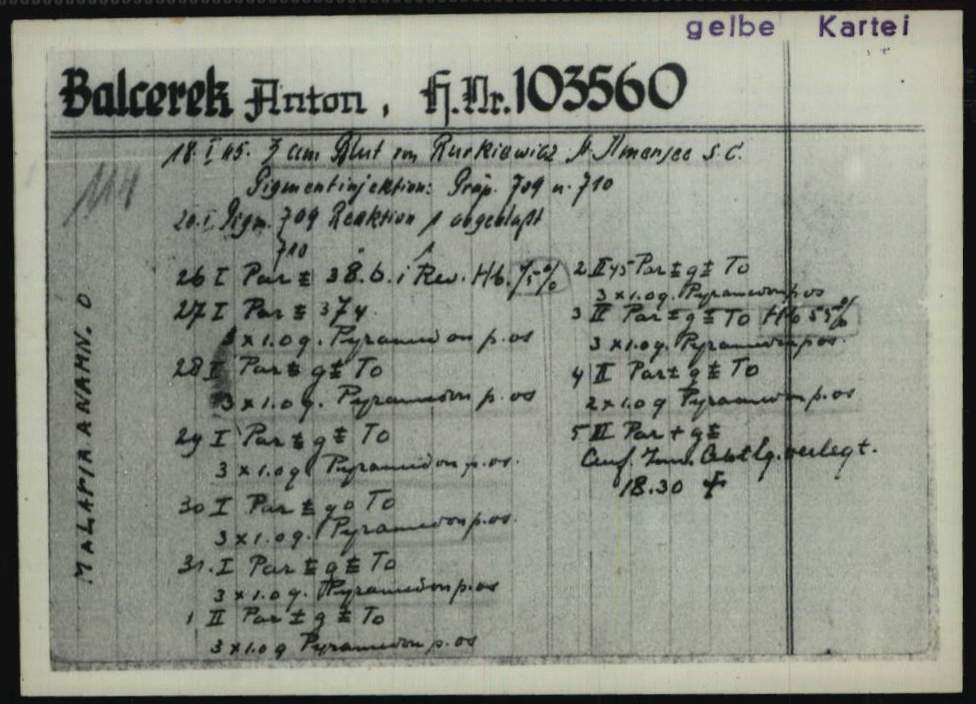
One card that is definitely not the most common document – in contrast to e.g. the prisoner registration form (Häftlingspersonalbogen) or the personal effects card (Effektenkarte) which were basically issued for almost every concentration camp inmate – but was quite a surprise for the team while working on the e-Guide was the “malaria card” from Dachau concentration camp (see Fig. 5).
Starting in February 1942, prof. Claus Schilling chose 1100 camp inmates for his pseudo medical experiments with the malaria virus. The course of the disease was noted on special cards. These were used at the ITS in recent decades to prove that a person was forced to participate in the experiment. As part of a compensation process during the 1960s the ITS compiled material on the various experiments in several concentration camps.5 Thus, members of the ITS contacted among others Eugène Ost who worked as writer (Revierschreiber) in the malaria station at Dachau concentration camp. On the basis of his letters – which are preserved in the ITS archive – it is possible to explain the card and its function. The information ranges from the place where the card was written to the name of the person writing it. Even the nationality of the inmate who wrote the name and the number on top of the card is given in one of the nine overlays that explain the cards in the e-Guide. More generally it is explained how the card worked and how one can make sense of the numbers and abbreviations on it. A description of the processes during the experiment can, for example, explain why there are gaps between the treatments which meant that the inmate had to return to his regular block and his work in the camp. Surely, the malaria card is a very specific example but it is suitable to show how the e-Guide can help to understand what the historical document can reflect of the lives of the concentration camp inmates.
BACK
Conclusion
The e-Guide is available over the ITS website since May 2018. Different groups will be able to benefit from it as it offers general information in a digital and interactive way. Thus, the e-Guide will not limit itself to a certain target group but will be a tool that gives answers to everyone – to a relative searching for information about the fate of a former camp inmate, to the student participating in a workshop, as well as to a historian who is using the ITS material for his or her research. As the descriptions relate not only to ITS documents but to general concentration camp cards that can be found in other archives as well, the guide will come in handy for a variety of people.
